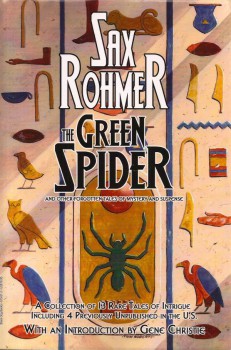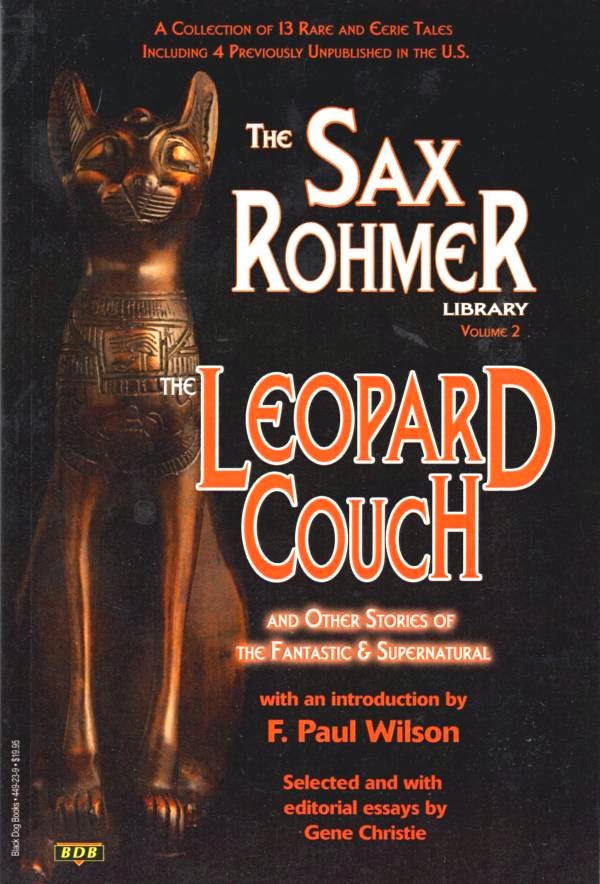Blogging Sax Rohmer… In the Beginning, Part Two

 “The Green Spider” marked Sax Rohmer’s third foray into short fiction. Still writing under the pen name of A. Sarsfield Ward, the story first appeared in the October 1904 issue of Pearson’s Magazine. It was not reprinted until 65 years later in Issue #3 of The Rohmer Review in 1969. Subsequently, a corrupted version, with an altered ending courtesy of the editor, appeared in the May 1973 issue of Mike Shayne Mystery Magazine. The restored text was included in the 1979 anthology, Science Fiction Rivals of H. G. Wells. More recently, the story has appeared in the 1992 anthology, Victorian Tales of Mystery and Detection, the September 2005 issue of Alfred Hitchcock Mystery Magazine, and as the title story in the first volume of Black Dog Books’ Sax Rohmer Library, The Green Spider and Other Forgotten Tales of Mystery and Suspense (2011).
“The Green Spider” marked Sax Rohmer’s third foray into short fiction. Still writing under the pen name of A. Sarsfield Ward, the story first appeared in the October 1904 issue of Pearson’s Magazine. It was not reprinted until 65 years later in Issue #3 of The Rohmer Review in 1969. Subsequently, a corrupted version, with an altered ending courtesy of the editor, appeared in the May 1973 issue of Mike Shayne Mystery Magazine. The restored text was included in the 1979 anthology, Science Fiction Rivals of H. G. Wells. More recently, the story has appeared in the 1992 anthology, Victorian Tales of Mystery and Detection, the September 2005 issue of Alfred Hitchcock Mystery Magazine, and as the title story in the first volume of Black Dog Books’ Sax Rohmer Library, The Green Spider and Other Forgotten Tales of Mystery and Suspense (2011).
The story itself shares in common with Rohmer’s first effort, “The Mysterious Mummy” the presentation of a seemingly supernatural mystery that has a rational explanation. In the nine months that elapsed between the publication of “The Leopard Couch” and “The Green Spider,” Rohmer honed his writing skills and became a more devoted student of Sir Arthur Conan Doyle and deductive reasoning. “The Green Spider” concerns the disappearance of the celebrated Professor Brayme-Skepley on the eve of an important scientific presentation. It appears to onlookers and Scotland Yard that the Professor has been murdered by a giant green spider that apparently made off with his corpse. The unraveling of the mystery reveals the green spider is no more authentic a threat than the phantom Hound of the Baskervilles. While a minor effort, the story retains its charm more than a century on and shows that the mysterious A. Sarsfield Ward was steadily improving as an author.
“The Mystery of the Marsh Hole” first appeared in Pearson’s Magazine in April 1905. The story was rescued from obscurity when it was included in Ace Books’ posthumous collection of Rohmer’s rare fiction, The Secret of Holm Peel and Other Strange Stories (1970). It likewise may be found in Black Dog Books’ The Green Spider and Other Forgotten Tales of Mystery and Suspense (2011). While it is far rarer than “The Green Spider,” the story is a marked improvement over its predecessor.

 Once more, Rohmer remains centered on the concept of a mysterious death that stumps the authorities having a rational explanation that an amateur detective uncovers. The character names this time around are noteworthy. Sedgley and Fennel would loan their names to future stories over the next few years (“The Sedgley Abbey Tragedies” and “The Haunting of Low Fennel,” respectively) while the hero’s first name, Saxham, would be shortened as its author’s new pseudonym in the near future as well.
Once more, Rohmer remains centered on the concept of a mysterious death that stumps the authorities having a rational explanation that an amateur detective uncovers. The character names this time around are noteworthy. Sedgley and Fennel would loan their names to future stories over the next few years (“The Sedgley Abbey Tragedies” and “The Haunting of Low Fennel,” respectively) while the hero’s first name, Saxham, would be shortened as its author’s new pseudonym in the near future as well.
“The Mystery of the Marsh Hole” is somewhat more plausible than “The Green Spider,” although it relies even more heavily upon The Hound of the Baskervilles for much of its inspiration. Saxham Leville makes for a passable Sherlock Holmes clone, despite not being given enough space to register much of a personality outside of being a brilliant amateur detective. The biggest interest for Rohmer fans is that the murder victim, Sir James Fennel, prefigures the character of Sir Lionel Barton from Rohmer’s later Fu Manchu series. The eccentricities of this renowned explorer with his native servants and love of the exotic holds the key to his untimely death.
“Who Was the Rajah?” was published in the November 1905 issue of The Royal Magazine and remained out of print for over a century until Gene Christie tracked down a copy for The Green Spider and Other Forgotten Tales of Mystery and Suspense in 2011. Originally subtitled “The History of a Gigantic Hoax,” the story sees A. Sarsfield Ward casting aside weird fiction and mystery writing for a stab at a swashbuckler. While readers can see the author stretching himself too thin in his portrayal of the 18th Century upper classes and their behavior, he acquits himself well in the creation of a roguish nobleman who leads a daring double life as a fearless pirate, while maintaining still another identity as a dashing rajah who charms men and women alike while setting up his next heist. The ending of the story makes it clear Rohmer hoped he was introducing a series character, but it was not to be.
None of these three early stories are classic Rohmer, but they do capture the author’s talent at a crucial stage of development. His writing was becoming more polished and it was evident he was paying close attention to the fiction he enjoyed (Conan Doyle, certainly and likely Baroness Orczy) to help him grow in his craft. Despite their limitations, these early efforts still hold interest for fans of vintage pulp fiction of the late Victorian period and help bridge the gap to the Edwardian thriller that Rohmer helped define.
William Patrick Maynard was authorized to continue Sax Rohmer’s Fu Manchu thrillers beginning with The Terror of Fu Manchu (2009; Black Coat Press) and The Destiny of Fu Manchu (2012; Black Coat Press). The Triumph of Fu Manchu is coming soon from Black Coat Press.